Review: When are feathers worth more than gold? ‘Kingdoms’ exhibition answers with spectacular finds
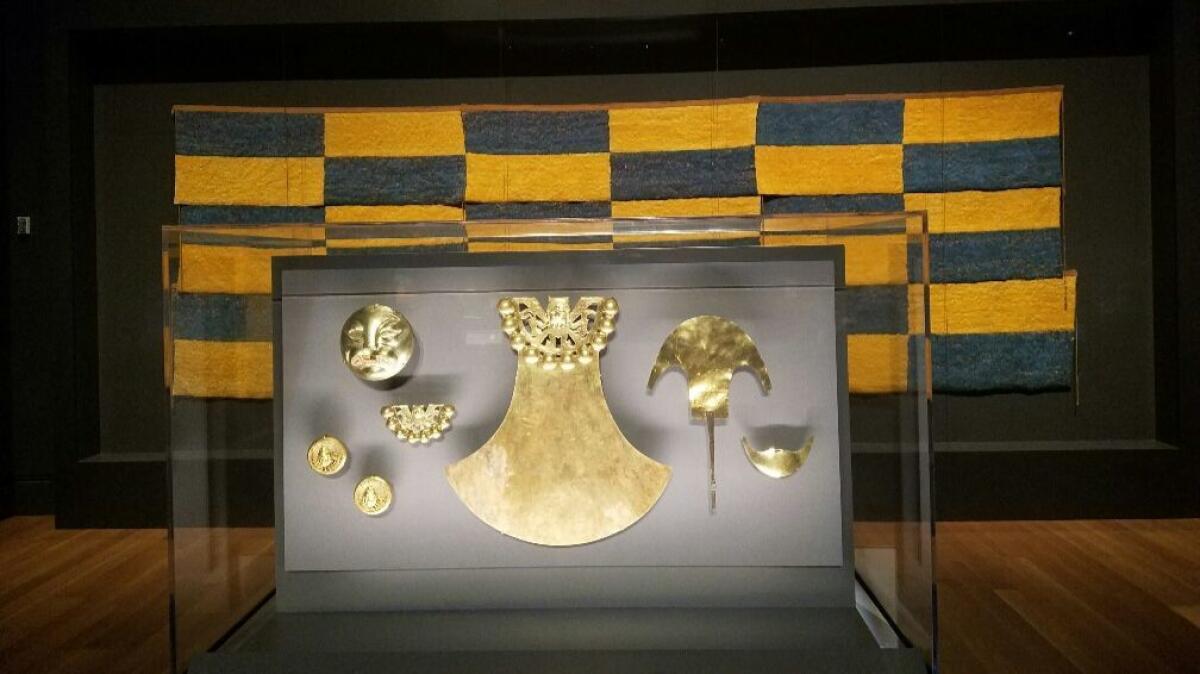
- Share via
Which is more valuable: a pound of gold or a pound of feathers?
The answer might seem obvious but depends on where you are, when. It hangs on the value system that a given society has in place.
If it’s 16th century Spain — or 21st century America — gold wins, hands down. But if it’s the Andes Mountains of South America before the first millennium, it’s feathers all the way.
Precious metal was neither absent from nor undesirable in the region of what is modern-day Peru, and it was used in all kinds of glittery ways. Gold was gorgeous, if only for its light-reflective properties, but just not that big a deal.
Feathers, on the other hand, were a wow — visually and conceptually.
A spectacular exhibition at the J. Paul Getty Museum offers stunning demonstration. “Golden Kingdoms: Luxury and Legacy in the Ancient Americas” brings together more than 200 resplendent objects dating from at least 1000 BC to the 16th century. For starters, compare just two of them, one near the entrance and the other at the exit.
First is a big, 21-foot-wide wall of rectangular fiber panels, each covered in solid blocks of feathers in rich royal blue and vivid marigold — tens upon tens of thousands of them, a gridded wall that is like a Post-Minimalist mural made from the dorsal and ventral feathers of parrots. The other is an imposing oil painting of dignified men, all decked out in sumptuous gold adornments.
The feathered panels were found in 1943, rolled up in ceramic jars and buried at a ceremonial site. It’s a long way from the macaws’ natural habitat in northwest Brazil to that burial ground in the far south of Peru. Exotic importation made the panels’ feathers, hailing from the Amazon rainforest, even more dear.
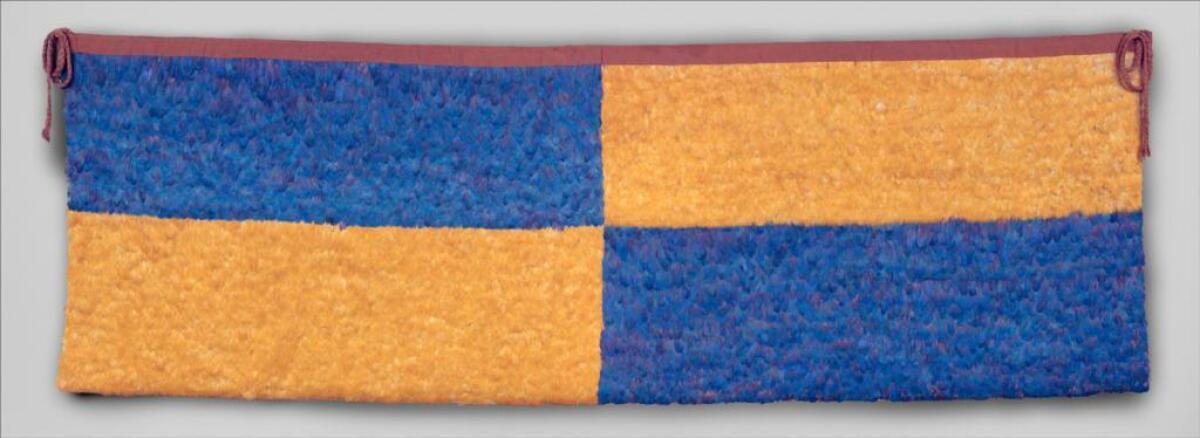
What was their function? Scholars are uncertain. The best guess is that the portable panels, which date to between AD 600 and 900, were originally meant as architectural adornments. Think of them as ancient Andean tapestries.
Imagine a chieftain’s council room lined in them. Organic objects and shapes are rigorously organized into rectilinear patterns.
Brilliant feathers dazzle, not unlike the gold threads that made the tapestries of medieval and Renaissance Europe such splendiferous and imposing works of art. But the capture of alien, airborne feathered creatures to make the ancient tapestries lends an inescapable element of supreme power facing the dominant muscle of natural elements that ruled so much of daily life. Humankind takes dominion over nature, while acknowledging its beauty and its grandeur.
Now look at the last work in “Golden Kingdoms,” a well-known painting by Andrés Sánchez Gallque dated 1599 that shows things from a point of view appealing to Renaissance Spain. “Portrait of Don Francisco de Arobe and his Sons Don Pedro and Don Domingo” was commissioned in Peru for “His Majesty Philip III, Catholic King of Spain,” as a cartouche in the upper right corner helpfully explains.
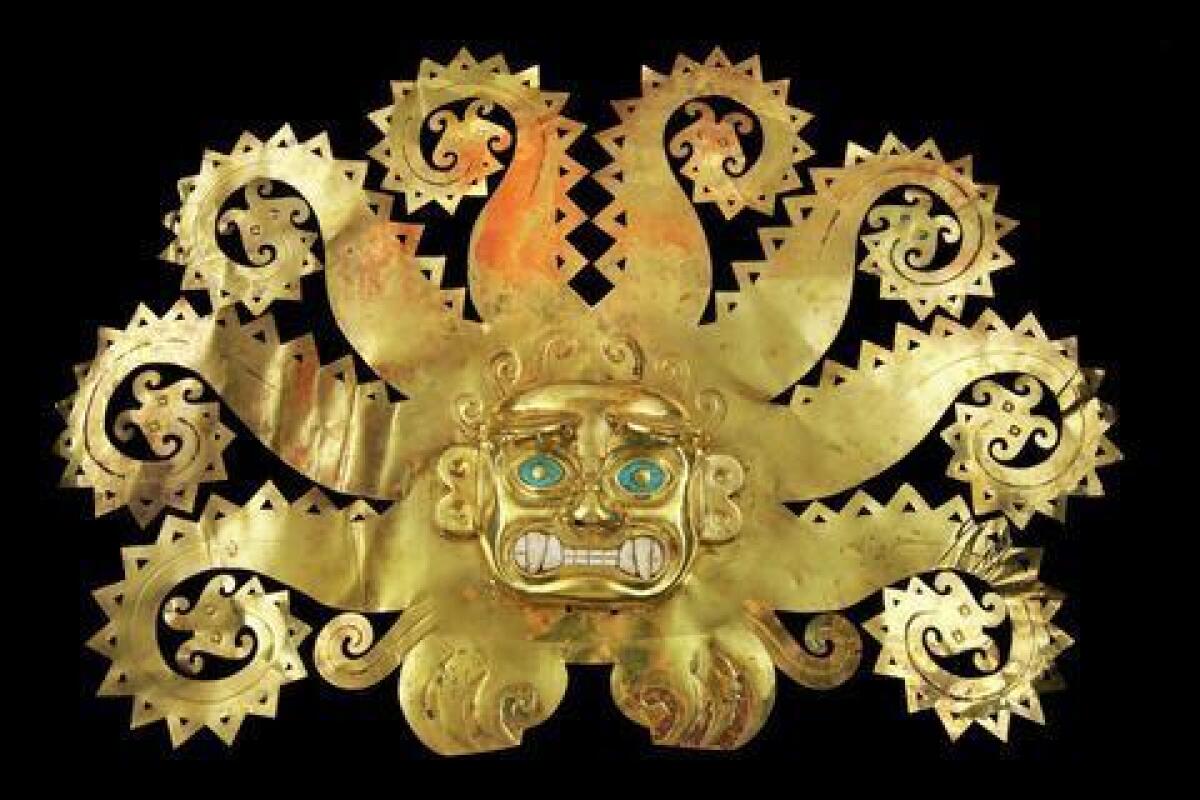
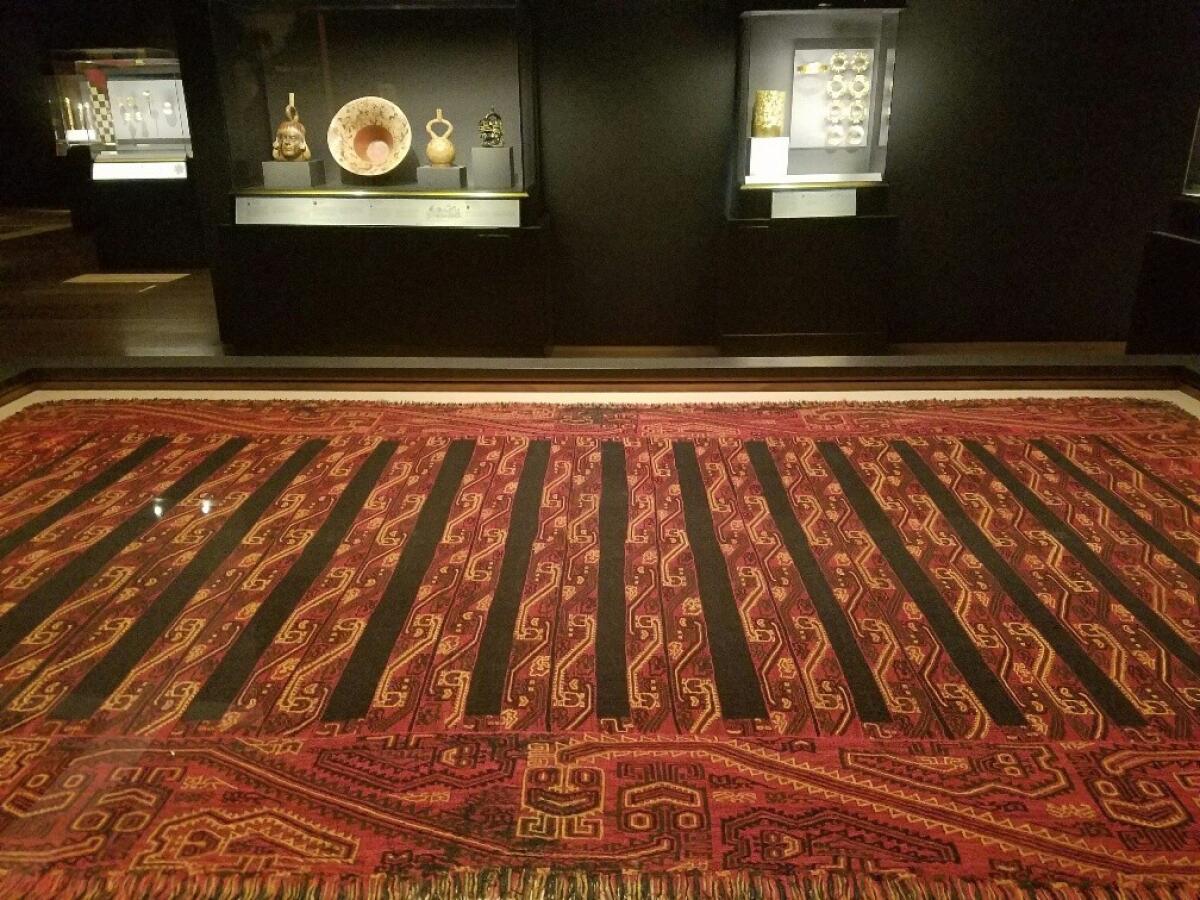
The stately triple-portrait meant to seal an important political alliance between the Spanish Crown and leadership in the Ecuadoran coastal region of Esmeraldas. Standing tall, the three have doffed their hats to the king.
A sumptuous compendium of extravagance merges Spanish doublets and ruff collars with Chinese textiles and Pacific seashells. The most eye-grabbing feature, however, is the abundance of gold jewelry — earrings, elaborate nose rings, a neck ring, chunky collar-necklaces, etc. The metal shines brightly, especially against the dark, Afro-Indian skin of the elegant trio, where it frames and accents their attentive faces.
Ten years later Philip would begin expelling the Moors from Spain. But gold told the king what he wanted to know about these black men from his colony across the ocean, and in a language of value he would understand: This chief and his two young sons, whom Philip would never meet but had to trust, were men of power and authority. Their word was as good as gold.
The exhibition has lots of the exquisite material — gold jewelry, plaques, cups, funerary masks, votive figurines, ceremonial tools, armor and more. A little 4½-inch spoon, to cite one very small example, was fashioned from 22 separate pieces of sheet-metal to create a golden figure squatting on his haunches and holding a silver conch shell to his lips, like a trumpet. The spoon was probably used to inhale hallucinogens during religious ceremonies.
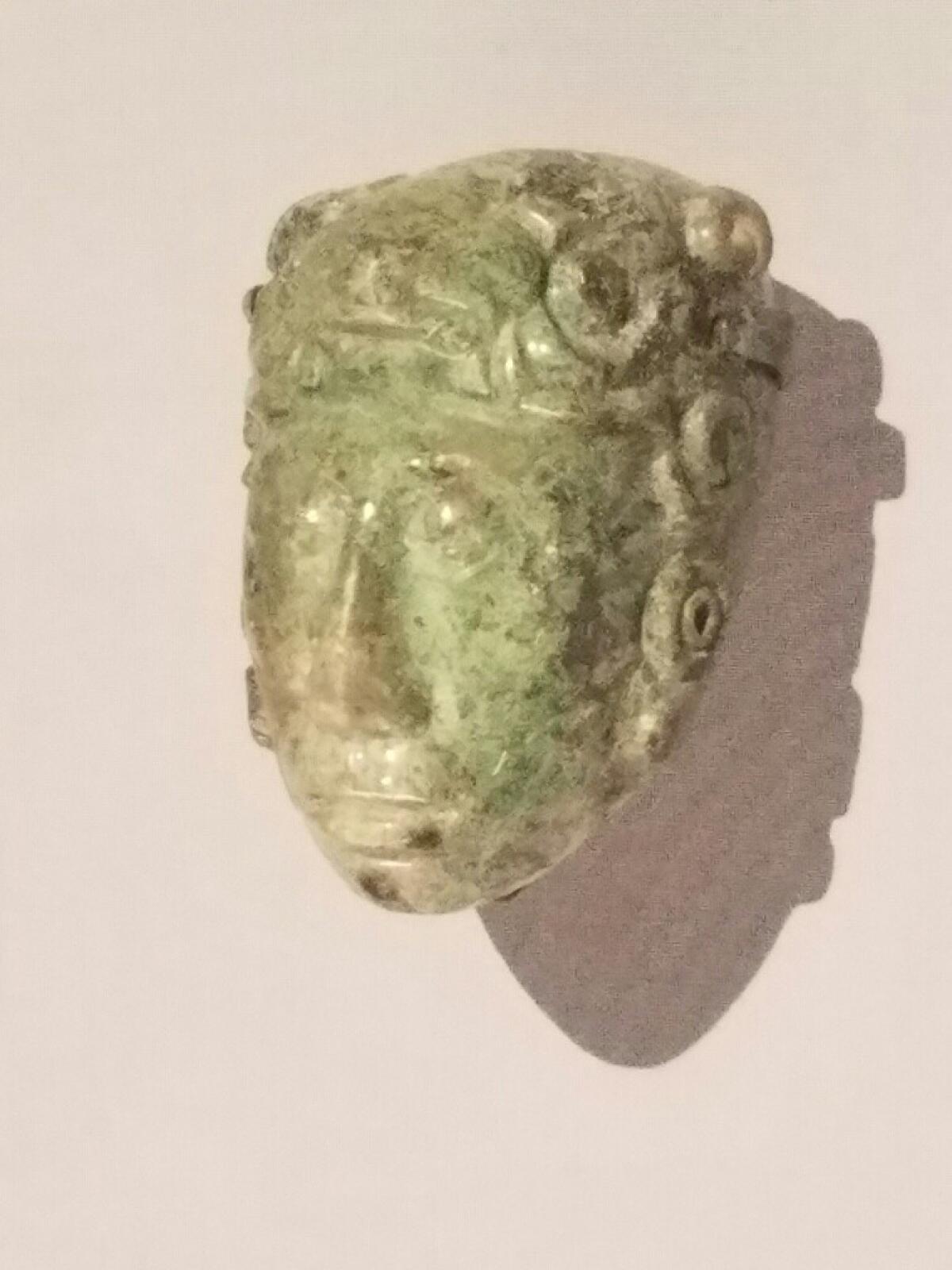
Elsewhere the design of a forehead ornament recalls an octopus, its eight jagged, spiraling arms culminating in stylized catfish heads. And flat T-shirts of solid gold may have been made to be sewn to cloth backing for use as armor, or else they were fabricated to cover a body during burial.
The brilliance of the extraordinary craftsmanship is heightened simply by knowing that much that was produced over the course of several thousand years by a variety of cultures — including Moche, Wari, Inca, Chiriquí, Tolima, Zapotec and Mixtec — was destroyed after Europeans arrived in the early 16th century. We’re seeing some of what survived in gold, but the friction between competing value systems generated enough heat to melt a lot of it down for hauling back to Spain. Given what remains, what was lost?
Gold is the show’s through-line, moving north along the Pacific coastline from the Inca Empire in Peru to Colombia, Panama, Costa Rica, Guatemala and Mexico, ending at Tenochtitlan. But other materials were also considered eminently suitable for luxury production, depending on the indigenous society. For simple clay, certain seashells and volcanic stone, the sophistication of applied decoration and carving — evidence of human mastery — did the trick.
For the Olmec and Maya, jade was the most valuable material. Among the show’s great treasures is a small, dignified head of an ancestor crowned by a jaguar headdress, carved in jade in Guatemala but found 300 miles north in the sacred well at Chichen Itza.
A cenote, or sinkhole, the well was a portal between the earthly realm and the watery underworld — and thus an excellent place to drop in your favorite luxury item as a serious bit of spiritual offering. (People, alas, got sacrificed there too.) Just over 3 inches high, the noble head feels monumental — a piece of power-stone.
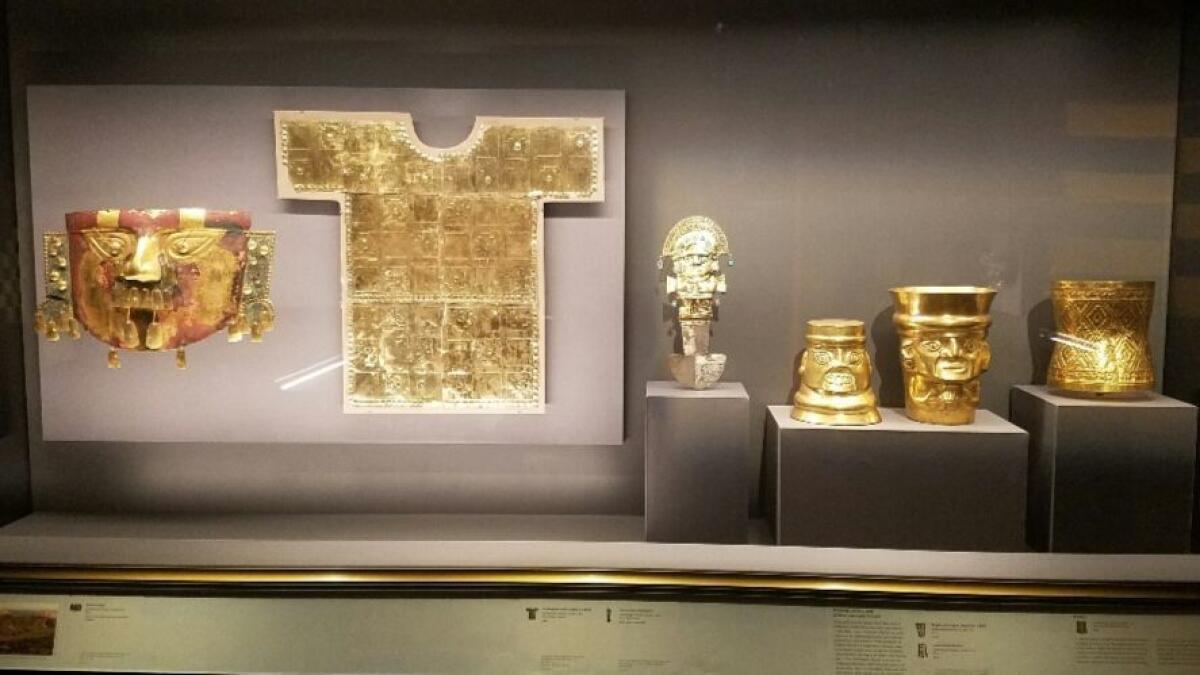
Originally worn as a belt ornament, the sculpture is marked on the bottom with a tangle of pictographs — among them the artist’s name, perhaps the only example of ancient Mesoamerican jade signed by its maker. Surely that’s an indication of the value assigned to achieving such aesthetic refinement.
There are wonderful surprises, including a dark, iron-gray, stirrup-spout ceramic bottle in the shape of conjoined seashells — one a twirling conch, the other a spiny bivalve mollusk. They shouldn’t go together but they do, a formally distinct odd couple that seamlessly manages to get along. It’s from the Cupisnique culture, which is new to me, that flourished along the coast of northern Peru beginning more than 3,000 years ago.
Some things are more familiar, although the show’s rich context makes them sing anew. At the top of that list is a large, fringed mantle that’s a treasure in the collection of the Los Angeles County Museum of Art, used as a burial wrapper a few millennia ago. The large, intricate pattern of interlocking serpent and feline creatures echoes the sophisticated material weave and embroidery of its slender threads in red, black, indigo and white. Structuralism, matching visual image and physical form is at work, courtesy of the ancient Americas.
The magnificent show was organized by Getty Museum Director Timothy Potts, Getty Research Institute specialist Kim Richter and Joanne Pillsbury, curator at New York’s Metropolitan Museum of Art, where it travels in February. A standout in the sprawling Pacific Standard Time: LA/LA initiative celebrating art throughout Latin America — and the only Pre-Columbian component — it’s on view in Brentwood through Jan. 28.
♦ ♦ ♦ ♦ ♦ ♦ ♦ ♦ ♦ ♦
‘Golden Kingdoms: Luxury and Legacy in the Ancient Americas’
Where: J. Paul Getty Museum, 1200 Getty Center Drive, Brentwood
When: Through Jan. 28; closed Mondays, Christmas Day and New Year’s Day
Info: (310) 440-7300, www.getty.edu
Twitter: @KnightLAT
RELATED STORIES:
'Painted in Mexico': LACMA's remarkable and important new show
Richard Meier on the Getty Center as it turns 20
Malpaso Dance brings its breezy, charming surprises from Cuba
The biggest entertainment stories
Get our big stories about Hollywood, film, television, music, arts, culture and more right in your inbox as soon as they publish.
You may occasionally receive promotional content from the Los Angeles Times.







